
The Himalayas of India: Ladakh and Dharamsala,
Summer 2008
Himachal Pradesh - McLeod Ganj, Delhi, The Lotus Temple, Connaught Place, Waylon
Page 16 of 16
 After
visiting the Sherab Gatsel Lobling School and Ronny and Rebecca, I walked
back up to the hotel, emailed, and ran over just in time to teach at Gu Chu
Sum. Nyima was already in the hall waiting at 6:30. After
visiting the Sherab Gatsel Lobling School and Ronny and Rebecca, I walked
back up to the hotel, emailed, and ran over just in time to teach at Gu Chu
Sum. Nyima was already in the hall waiting at 6:30.A while back, I had given thought to how I would teach ex-political prisoners English. My guess was most of the well-meaning foreigners had asked the same questions such as, "What happened to you in prison?" and "Do you miss your family?" as they had with the nun, Tsering Tsomebody, at Khana Nirvana Cafe. And many ex-political prisoners volunteer this information anyway. I hoped to engage them on other topics. Three days ago, we spoke about polyandry and songs of the Dalai Lama. This evening, I started speaking about Tso Pema and Padmasambhava. This sparked great interest in the two. Nyima and Palden animatedly told the story about the king of Mandi setting fire to Padmasambhava for teaching the Dharma to his daughter, him shrugging it off and reappearing in a lotus in the middle of a lake as I mentioned on Page 14. I was so unbelievably proud of them for being able to relate the whole story that I just smiled and kept saying how proud I was of their effort and success. They beamed. Photo: Nyima, their roommate, and Palden. The three of them share a small room together at Gu Chu Sum, in back of Lung-Ta Japanese Vegetarian Restaurant. |
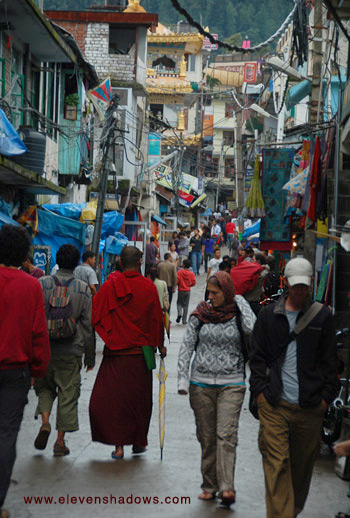 2
August - I tried emailing to wish my brother a happy birthday despite it
being the 1st of August back home, but the internet all over Dharamsala was
down. I walked down Jogibara Road to Ronny and Rebecca's house,
running into two students from Sherab Gatsel Lobling School on the way.
Today I was to consult with Tenzin, who worked at the Centre for Tibetan Studies by the
Tibetan Library about building a recording studio there. He was their
resident computer guru. 2
August - I tried emailing to wish my brother a happy birthday despite it
being the 1st of August back home, but the internet all over Dharamsala was
down. I walked down Jogibara Road to Ronny and Rebecca's house,
running into two students from Sherab Gatsel Lobling School on the way.
Today I was to consult with Tenzin, who worked at the Centre for Tibetan Studies by the
Tibetan Library about building a recording studio there. He was their
resident computer guru.Tenzin asked very intelligent questions about the recording studio. And the pro audio company, PACE, had given him very sensible suggestions. I suggested several cheaper alternatives that would work perfectly fine. We discussed the pros and cons of each choice, potential compatibility issues, servicing, support, training, glass wool being used for bass traps. He absorbed it all, writing much of it down. ~~~~ I went back up the hill, running into a very interesting guy named Danny from Scotland, who I had run into in Dharamkot during my quest for delicious Israeli food. We hung out at Moonpeak Cafe, eating apple pie and conversing. I eventually walked back to my hotel for a bit, taking this photo of Jogibara Road, realizing how much I would miss this place. The streets of McLeod Ganj are full of life, yet somehow peaceful, and I'm not sure how many places you can say that about. |
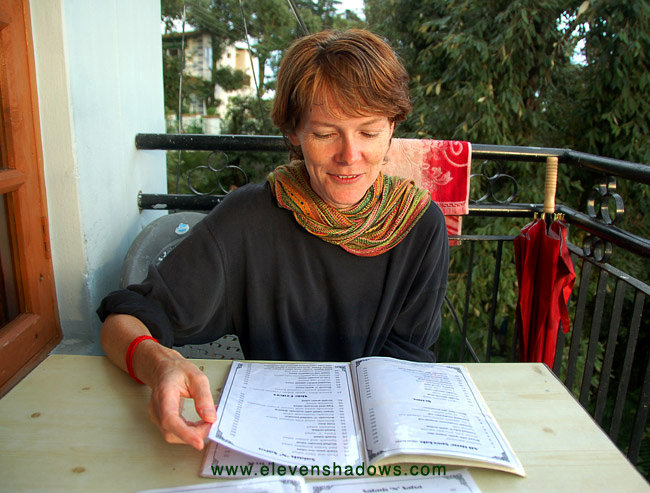 I
met Rebecca up at Pema Thang Restaurant for dinner, the same place where
Kelsang Chukie Tethong and some Tibetan musicians had played traditional
music before. I
met Rebecca up at Pema Thang Restaurant for dinner, the same place where
Kelsang Chukie Tethong and some Tibetan musicians had played traditional
music before.
The food was delicious. It was good to hang out, get to know her and Ronny better, and not just talk about The Tibet Connection, although of course we did that too. |
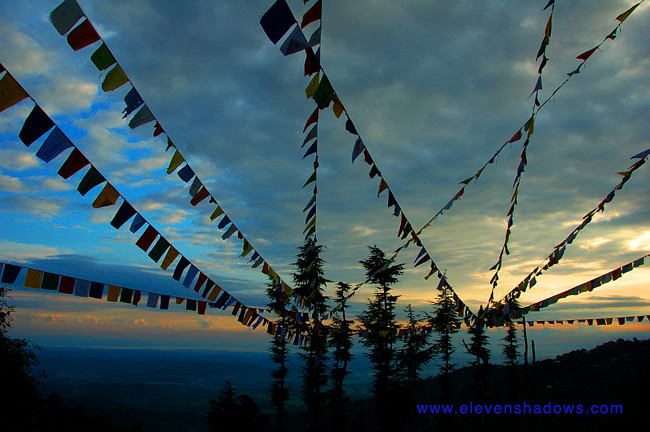 Peaceful
sunset looking out over the Kangra Valley from the balcony at Pema Thang
Restaurant. Peaceful
sunset looking out over the Kangra Valley from the balcony at Pema Thang
Restaurant. |
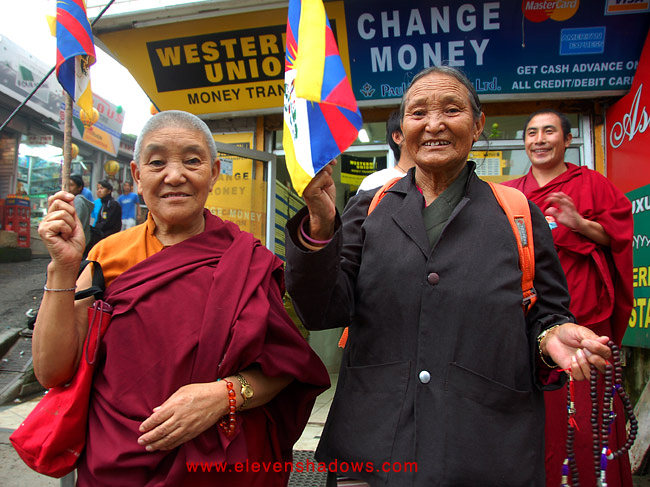 3
August - Today I had to go back down to Delhi. I was sad to leave
Dharamsala, but also sad that I had to go to Delhi. 3
August - Today I had to go back down to Delhi. I was sad to leave
Dharamsala, but also sad that I had to go to Delhi.
However, Students for a Free Tibet had told me there'd be a Freedom Torch Parade at the Main Bus Stand at 10:30. I couldn't possibly miss that! |
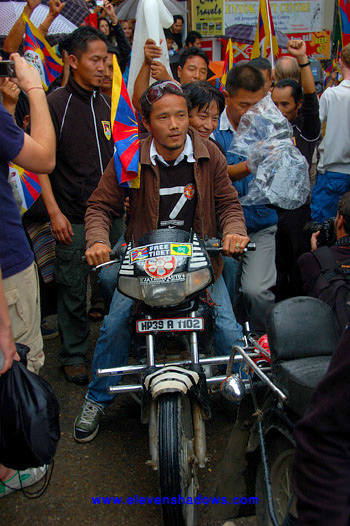 We
shouted "Lha Gyalo!" at the top of our lungs while motorcyclists slowly
rolled past, one holding a white torch. Tibetans waved flags. We
shouted "Lha Gyalo!" at the top of our lungs while motorcyclists slowly
rolled past, one holding a white torch. Tibetans waved flags.
I ran into Lis, who I had gone to the Karmapa Temple with. She wanted to help out with the Transit School and said she might be able to help raise additional funds for the water filtration system or the solar panels. And I ran into another guy I'd met at Lung-Ta. He was less than impressed by the proceedings. "What's the point of all this protesting? The Chinese government isn't here to see it, and if they were, they wouldn't care!" I replied, "That's true, their government won't care. But I think there's a few reasons to do this. One is publicity. There's film crews here. But maybe more importantly, this creates a sense of community, interdependency, unity, helping each other. It's important to maintain the culture and teach the importance of these things to the Tibetan kids and keep it going. They're in a foreign country now, and keeping their identity is important." He nodded his head, agreeing. "I think that's right. Community is it. Teaching these kids about being Tibetan is important." I was surprised at how I had just blurted out my response. I had not really attended any Buddhist teachings here, but maybe I had learned a little about unity and interdependency from the Ladakhis and the Tibetans after all, if only through osmosis. |
 Three
more people who turned out for the Tibetan Freedom Torch Parade. Three
more people who turned out for the Tibetan Freedom Torch Parade.I purchased a 150Rs woven bag to hold all the books and gifts I had purchased. But it began to rain heavily. I ran back. It continued to rain very heavily as I packed my belongings in preparation to go down to Delhi, my heart heavy in having to leave, but alternately buoyed by being able to go back home eventually. |
 4
August - I walked around Connaught Place in Delhi, and tried to go to
the Bengal Emporium to buy some clothes for Tom's mother but was told it was
temporarily closed. I wandered to Janpath Market, filled with Tibetan
shops. They had very recently remodeled it. I didn't think it
was as fun as before, but could understand why they'd done it. I got
ornate brown Tibetan teacups and silver carved incense burners for gifts for
my
bandmates, then went to
Fabindia to pick up some other things on Tom's mother's shopping list.
Overheated, I took a shower, rested, and went next door to Pizza Hut. 4
August - I walked around Connaught Place in Delhi, and tried to go to
the Bengal Emporium to buy some clothes for Tom's mother but was told it was
temporarily closed. I wandered to Janpath Market, filled with Tibetan
shops. They had very recently remodeled it. I didn't think it
was as fun as before, but could understand why they'd done it. I got
ornate brown Tibetan teacups and silver carved incense burners for gifts for
my
bandmates, then went to
Fabindia to pick up some other things on Tom's mother's shopping list.
Overheated, I took a shower, rested, and went next door to Pizza Hut.When I'm traveling, I almost never go to American chain restaurants. But on a hot day, when an air-conditioned Pizza Hut offers Punjabi pizzas and mango drinks and they're right next door, it's impossible to resist. I tried to blot out learning that their parent company had pesticides in their soft drinks here in India and that I was a hypocrite. And yes, the pizza was good. And yes, it was good to get out of the sweltering heat for an hour. That evening, I was treated to a delicious dinner at the members-only India International Centre in Lodi Estate with Kishore, a friend of Ronny and Rebecca's last night. His wife accompanied us. She works for an NGO for children's rights and is from Bengal. Kishore is a financial planner, and has also traveled extensively in Spiti (he has written a book on this region) and Ladakh. Both were engaging, intelligent, and funny, and I was happy to make friends with them. |
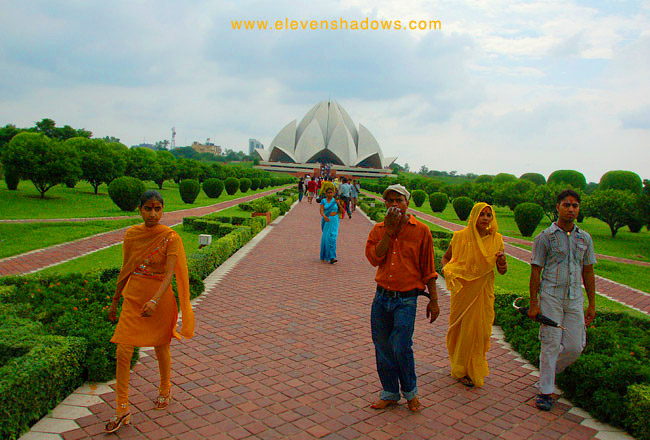 5
August - I did not sleep well and threw up during the night. Was it
possible that I may have gotten sick from what was by far the poshest place
I'd eaten the entire trip? The food tasted great. 5
August - I did not sleep well and threw up during the night. Was it
possible that I may have gotten sick from what was by far the poshest place
I'd eaten the entire trip? The food tasted great.I didn't eat anything, just drank a lot of water and took stuff to immobilize my stomach. Finally, I thought, I'm not going to spend the entire day locked in a tiny hotel room, so I took an autorickshaw to the Baha'i Temple (Lotus Temple), which I had previously visited in 1989 with Tom and his cousin Mitu. |
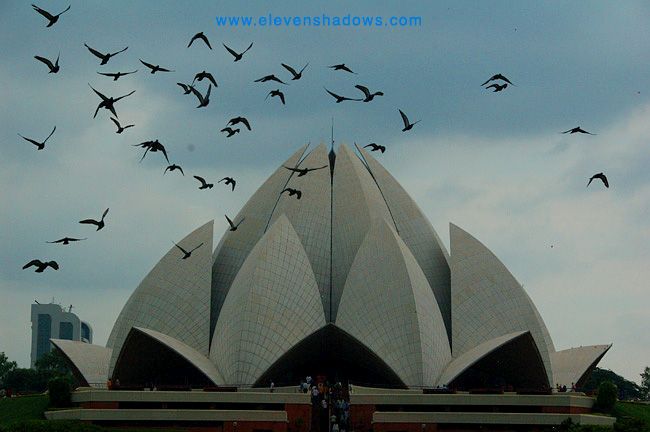 The
inclusive Baha'i faith was founded by Bahá’u’lláh, a Persian nobleman from
Tehran who, in the mid-19th century, abandoned his life of comfort and,
despite intense persecution, brought a message of peace and unity. The
inclusive Baha'i faith was founded by Bahá’u’lláh, a Persian nobleman from
Tehran who, in the mid-19th century, abandoned his life of comfort and,
despite intense persecution, brought a message of peace and unity.Bahá’í followers view Bahá’u’lláh as the most recent in a succession of divine Messengers sent from God, a line that includes Abraham, Krishna, Moses, Zoroaster, Buddha, Christ, and Mohammed. Islamic followers in Iran didn't take kindly to this new Messenger, and banished and imprisoned him for much of his life. I visited their Information Centre and the temple, sitting quietly for many minutes until my stomach began feeling ill again. The fear of throwing up in that glorious temple drove me out of the door and back to the hotel. |
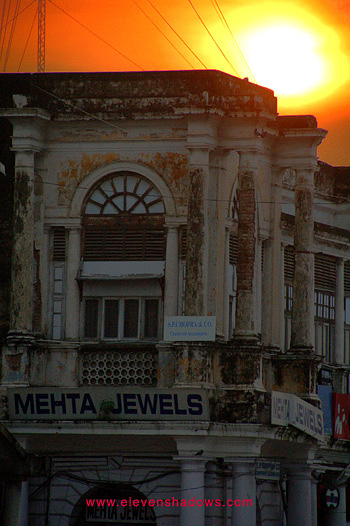 After
sleeping for a while upon returning from the Baha'i Temple, I stepped out of
the hotel at 7:30 with my camera. I had been to Delhi five times, but
had never taken photos of Connaught Place. The day was extremely hazy,
rendering the sunlight oddly orange. After
sleeping for a while upon returning from the Baha'i Temple, I stepped out of
the hotel at 7:30 with my camera. I had been to Delhi five times, but
had never taken photos of Connaught Place. The day was extremely hazy,
rendering the sunlight oddly orange. |
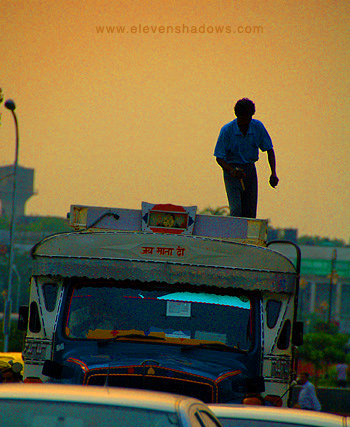 Atop
a truck near Connaught Place's Inner Circle. Atop
a truck near Connaught Place's Inner Circle.Connaught Place, or CP, (officially Rajeev Chowk) is India's second largest financial, commercial and business center after Nariman Point in Mumbai, and is at the heart of New Delhi. I know my way around CP fairly well. As far back as 1988, when I had stayed with Tom's family near the Ramakrishna Temple at Panchkuian Road, I had been walking over to CP, always visiting the Central Cottage Industries and the Tibetan shops on Janpath and going to the bookstores, shops, and post office there. But that was a very different India. Back then, a crowd would wait for the doors of the post office to open up, then burst inside, waving their packages at the counter, yelling, squeezing in as if it were a 1970s college prank. Back then, I tried to make a long-distance call home from Tom's family's apartment. I called the operator, asking to call the U.S. "I'll call you back when there's an open line, sir." Puzzled, I hung up, and after a while, talked and forgotten about the phone call. But at 5:30 in the morning, the phone rang, waking me up. "Sir, I have an open line for you now." |
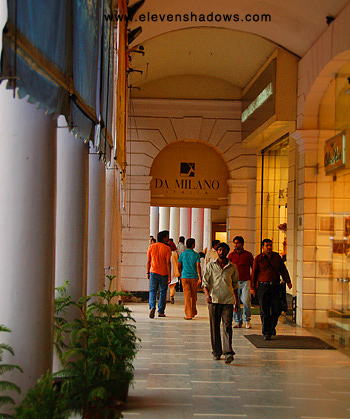 Connaught
Place's Victorian architecture is modeled after the Royal Crescent in Bath,
England. The area is a big circle in the middle with radial roads
spreading out like spokes on a wheel. CP was designed by Robert Tor
Russell, chief architect to the Government of India, in 1932 when the
British were here, basing it upon an outline by W.H. Nichollas (the
committee's architect from 1913-1917). CP has a lot of upscale shops,
hotels, cinemas, and restaurants mixed in with the underground Palaki Bazaar
and many street vendors. Connaught
Place's Victorian architecture is modeled after the Royal Crescent in Bath,
England. The area is a big circle in the middle with radial roads
spreading out like spokes on a wheel. CP was designed by Robert Tor
Russell, chief architect to the Government of India, in 1932 when the
British were here, basing it upon an outline by W.H. Nichollas (the
committee's architect from 1913-1917). CP has a lot of upscale shops,
hotels, cinemas, and restaurants mixed in with the underground Palaki Bazaar
and many street vendors.And I should mention that many of the places are air-conditioned. This is important in the summer. |
 CP
has a KFC and Rodeo, a Mexican restaurant. When I first went to Rodeo,
it had an Western American cowboy motif. Bar stools looked like
saddles, waiters like gunslingers, and menus like cowboy boots. The
menu greeted you with "Howdy Pardner!" I loved it. It was fun!
The fajitas were good. It didn't quite taste Mexican, but no matter.
It was good. And you could get Coronas with limes. It was a little
taste of home. CP
has a KFC and Rodeo, a Mexican restaurant. When I first went to Rodeo,
it had an Western American cowboy motif. Bar stools looked like
saddles, waiters like gunslingers, and menus like cowboy boots. The
menu greeted you with "Howdy Pardner!" I loved it. It was fun!
The fajitas were good. It didn't quite taste Mexican, but no matter.
It was good. And you could get Coronas with limes. It was a little
taste of home.In 2005, I told several tourists about the motifs. They thought that sounded great, so we went. But it had been remodeled. Now there were Mexican blankets and sombreros on the walls. "What happened to the cowboy outfits and the barstool saddles?" The waiter waggled his head. "Oh, sir, this was not looking like a Mexican restaurant." |
| I rested, then left the
hotel around 11:00pm for the international airport. I had a 2:30am
flight back home. This time, I had no rock stars to sit next to, just
some books and bad in-flight movies. I still was sick and kept going to the
bathroom. 24 hours later, I was happy to be home. Lisa was
there. Willie the three-legged cat was there. What was odd, though, was that Waylon was no longer there. He was not there to leap up on the table and rest his head on the Escape Key while I was using the computer. He wasn't there to drink out of the kitchen faucet. I had moved him away when he did these things. It'd be okay now, he could do these things. But he was no longer there.
And the other odd thing. I was home just a short while. Hardly more than 24 hours later, we were leaving to catch a plane to West Virginia. That was always good. But that's on another page. |
The Himalayas of India: Ladakh and Dharamsala, Summer 2008
Page 16 of 16
1 2 3 4 5 6 7 8 9 10 11 12 13 14 15 16
Eleven Shadows Travel Page
Contact photographer/musician Ken Lee